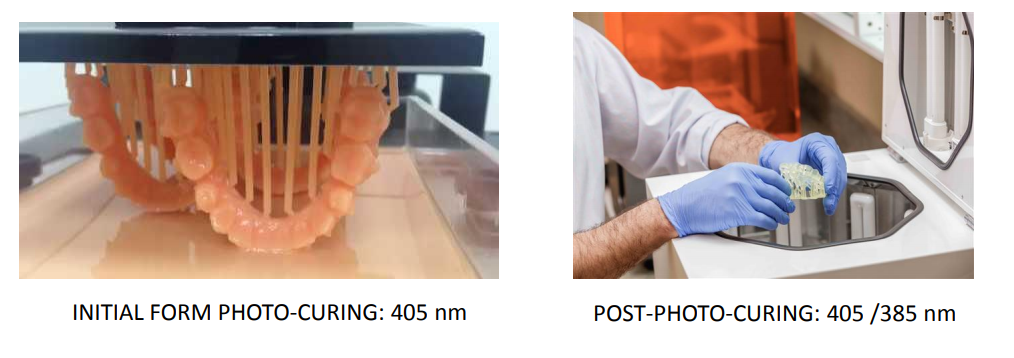Researchers from the Dental College of Georgia, Augusta University, are exploring better ways to perform dental restoration, detailing their findings in the recently published ‘Photoinitiator Types Among a Variety of 3D Printing Monomers.’
As 3D printers have begun to make significant and noticeable impacts in dental and orthodontic labs around the world, a variety of hardware, software, and materials have sprung up, allowing for the direct fabrication of items like:
- Denture bases and teeth
- Temporary restorations
- Splints
- Impression trays
- Surgical guides
- Casts
- Try-in set-ups
- Stents
Although there is a range of printers to choose from, the researchers are concerned with the quality of ‘the light-curing sources used for the printing and post-cure processes match the spectral absorption profiles of photo-initiators present in a variety of different types of dental 3D printing resins.’
 So far, R&D from a variety of manufacturers and labs has yielded desktop 3D printers that offer great accuracy and surface feature details, providing much greater freedom for dental offices as they can create items on demand while enjoying all the benefits of 3D printing—from offering patient-specific treatment and products that can be greatly customized to enjoying greater affordability and speed in production.
So far, R&D from a variety of manufacturers and labs has yielded desktop 3D printers that offer great accuracy and surface feature details, providing much greater freedom for dental offices as they can create items on demand while enjoying all the benefits of 3D printing—from offering patient-specific treatment and products that can be greatly customized to enjoying greater affordability and speed in production.
“Contemporary dental 3D printing typically involves use of near or true ultraviolet radiation (405 nm & 385 nm, respectively) in order to fabricate the basic desired form from a vat of photo-polymerizable monomers,” explain the researchers.
“Subsequent to initial form fabrication, the specimen is alcohol-washed of excess surface monomer, and is then subjected to an additional exposure of strong near/UV light, in order to maximize the polymerization process and provide optimal physical properties, as well as to minimize cytotoxicity resulting from leaching of unreacted, residual monomer within the bulk of the as-printed item.”
For this study, the research team used six different photoinitiators for UV-photopolymerization of acrylates, to include:
- OMNIRAD 2100 – mixture of TPO-L and Irgacure 819
- TPO-L (not obtainable) – also known as Ethyl phenyl (2,4,6 trimethylbenzoly) phosphinate (an MAPO)
CAS 84424-1 1-7 - OMNIRAD 819 – 819 (formerly Irgacure 819)
- Lucirin TPO – TPO ( a MAPO)
- OMNIRAD 184D – D (formerly Irgacure 184D )
also known as 1-hydroxycyclohexylphenyl ketone
CAS 947-1 9-3 - OMNIRAD 1173 – 3 (formerly Irgacure 1173) also known as 2-hydroxyl-2-methylpropiophenone CAS 7473-9 8-5
Overall, results showed that the content of most resins was identifiable, although there was no consistency found in photoinitiator content among the materials.
“Knowledge of spectral needs of photoinitiators will help 3D printer/post-cure operators better understand the light source needs of different resins and to fabricate polymer forms having optimal physical and biocompatible properties,” concluded the researchers. “There is more relative absorption of photoinitiator at 385 nm than at 405 nm. Initial printing and subsequent post-cure might be more efficient using 385 nm, provided 385 nm has low attenuation within the printed model.”
What do you think of this 3D printing news? Let us know your thoughts! Join the discussion of this and other 3D printing topics at 3DPrintBoard.com.
[Source / Images: ‘Photoinitiator Types Among a Variety of 3D Printing Monomers’]Subscribe to Our Email Newsletter
Stay up-to-date on all the latest news from the 3D printing industry and receive information and offers from third party vendors.
Print Services
Upload your 3D Models and get them printed quickly and efficiently.
You May Also Like
The Dental Additive Manufacturing Market Could Nearly Double by 2033, According to AM Research
According to an AM Research report from 2024, the medical device industry, specifically in dentistry, prosthetics, and audiology, is expected to see significant growth as these segments continue to benefit from...
Heating Up: 3D Systems’ Scott Green Discusses 3D Printing’s Potential in the Data Center Industry
The relentless rise of NVIDIA, the steadily increasing pledges of major private and public investments in national infrastructure projects around the world, and the general cultural obsession with AI have...
AM Research Webinar Explores Continuum’s Sustainable Metal Additive Manufacturing Powders
Metal additive manufacturing (AM) powder supplier Continuum Powders is working to develop solutions that empower industries to reduce waste and optimize their resources. An independent life cycle assessment (LCA) of...
3D Printed Footwear Startup Koobz Lands $7.2M in Seed Round
California-based Koobz is focused on reshoring the U.S. footwear supply chain with advanced manufacturing processes, including 3D printing. The startup just announced that it has added $6 million to its...

































